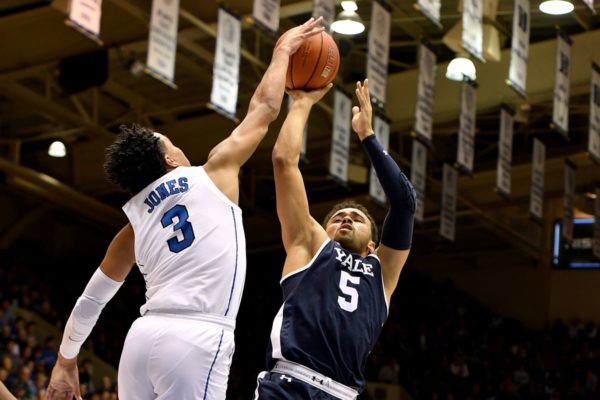Finals Week Analysis: Addressing Duke’s Preseason Questions
Posted by Brad Jenkins (@bradjenk) on December 12th, 2018Heading into the 2018-19 season, we knew that Duke’s talent would be at a very high level, but there were a handful of legitimate questions surrounding Mike Krzyzewski’s youthful club. With 10 games now in the books and students in the midst of finals, it seems like a good time to assess how the Blue Devils are addressing those preseason concerns. Duke’s 9-1 record has been achieved with superstar freshmen Zion Williamson and RJ Barrett grabbing most of the headlines, but two of their classmates may hold the key to a truly spectacular season.

Question #1: Would the Blue Devils be able to play effective man-to-man defense?
In the preseason, Krzyzewski praised the defensive potential of his team, citing its quickness and length on the perimeter. In recent years, however, Duke has not been very successful in executing Coach K’s favored pressure man-to-man defense. Youth cannot entirely be blamed for those struggles — those teams frequently had effort issues as well. For example, halfway through last season, the Blue Devils’ defense was so bad that Krzyzewski gave up on it and began exclusively playing zone. Based on Duke’s current defensive numbers, that will not be a problem this year. The Blue Devils currently rank fifth in KenPom’s defensive efficiency ratings, while holding opponents to very good shooting rates — 42.4 percent shooting on two-pointers, and 28.2 percent from behind the three-point line.
According to Krzyzewski, freshman point guard Tre Jones deserves most of the credit for the defensive resurgence. Jones’ pressure on the ball is something we haven’t seen from a Blue Devils guard in many years — maybe since Chris Duhon 15 years ago. This allows Duke’s rangy wings to get in passing lanes, generating live-ball turnovers that often lead to showtime dunks at the other end. Duke leads the nation in steal percentage (14.5%) and is forcing turnovers on 21.8 percent of opponents’ possessions (50th nationally). In the previous four seasons, the Blue Devils have not been among the nation’s top 200 teams in forcing miscues. Gonzaga last month achieved some success in attacking Duke’s ball-screen defense when Marquise Bolden was on the floor, but Krzyzewski’s counter to that strategy may be to give more minutes to the more mobile Javin DeLaurier. DeLaurier, who allows the Duke defense to switch at all five spots, made his first start of the year against Yale last Saturday.
Question #2: How good (or bad) will the perimeter shooting be?
Duke has finished among KenPom’s top 10 offensive efficiency rankings in every year of the past decade. A big component of that success has been the Blue Devils’ sustained ability to knock down perimeter shots, year after year. Over the past nine campaigns, Duke has converted at least 37 percent of its shots from long-range, finishing well above the national average each year. While immensely talented, none of this season’s four ballyhooed freshmen came to college known for their expertise in shooting the ball. And with no returning players of note, outside shooting acumen was a huge question for this team heading into the Champions Classic. After 10 games, this is still a concern – Duke is currently making just 33.2 percent of its three-point efforts.
A deeper dive into the numbers, however, reveals that Duke’s perimeter shooting woes may not be as bad as its season mark suggests. The Blue Devils were ice cold in their last two outings, making just 10-of-47 from distance, but prior to those two games, they sank a respectable 36.0 percent of their three-point attempts. And perhaps surprisingly, Duke is shooting better when it faces tougher competition – making 37.6 percent from beyond the arc versus the five best defenses they have faced. One potential caveat here is that Krzyzewski’s club is too dependent on Cam Reddish’s game-to-game accuracy. As Duke’s highest-volume deep shooter, Reddish’s propensity for streakiness is concerning. After starting the year on fire – 10-of-21 from three-point range in his first two games – he has struggled lately. Reddish was largely responsible (1-of-14) for Duke’s poor three-point shooting in its last two contests, and a cold night from him could be problematic when Duke begins to tackle the better defensive teams in the ACC.










































